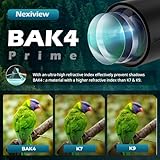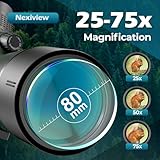 Advertising Disclosure
Advertising DisclosureSpotting Scopes Comparison - November 2025

Our Top 3 Picks
Here are the top 3 recommended products with more information to help you find the right product for you9.9
1VortexVortex Optics Diamondback HD Spotting Scope 20-60x85 Angled Green
Why we love it
Exceptional optical clarity and color fidelity.
Durable and weather-resistant construction.
User-friendly focus and adjustment features.
Main highlights- The scope is tripod adaptable allowing use on a tripod or car window mount. Arca-Swiss compatibility allows it to be mounted to Arca-Swiss tripod heads without using additional plates. Also accepts 1/4-20 threads for use on alternate style tripod heads.
- The redesigned Diamondback HD spotting scope has all the optical horsepower the western hunter needs, and excels in low light. It features a streamlined exterior for a sleeker profile and a built-in helical focus wheel for fast and fine adjustments.
- O-ring sealed and argon purged, the scope delivers waterproof and fogproof performance. Armortek coatings protect the lenses from oil, scratches, and dirt. Rubber armor enhances both durability and grip for the user.
- HD optical system delivers exceptional resolution, cuts chromatic aberration and provides outstanding color fidelity, edge-to-edge sharpness and light transmission. Multiple anti-reflective coatings on all air-to-glass surfaces increase light transmission
- Backed by our unlimited, unconditional, lifetime, VIP Warranty. A fully transferable promise to repair or replace your item if it becomes damaged/defective. Does not cover loss, theft, deliberate damage or cosmetic damage that doesn't hinder performance.
- Adjustable eyecups twist up and down for comfortable viewing with or without eyeglasses. The built-in sunshade reduces glare and shields the objective lens from raindrops and snow.
9.8
2Gosky31% OffGosky Flagship DiamondEdge 20-60x80 Spotting Scope with Tripod, Carrying Bag and Quick Phone Holder - BAK4 High Definition Waterproof Spotter Scope for Bird Watching Wildlife observing,Green
Why we love it
High-quality image at all magnifications.
Durable and weather-resistant design.
Includes smartphone adapter for easy photography.
Main highlights- Variable 20x to 60x magnification and dynamic lens focusing system - makes it easy to zoom in. Perfect for archery, bird watching, wildlife watching, hiking, camping, scenery, outdoor sporting, astronomical observation etc.
- Nitrogen filled waterproof and fog-proof design enables the scope to withstand the toughest environments. Durable Framework and Rubber Armor provide non-slip grip, shock-proof grip and durable external lasting protection. The eyepiece shield can be stretched out to protect the eyepiece
- Includes tabletop full metal tripod and tripod mount for steady observations. The carry case, eyepiece and lens protection covers, cleaning cloth make you more convenient to carry and maintain.
- Fully multi-coated 80mm green film objective lens provides a field of view at 82.9-48ft/1000yards. The quality BAK4 Porro prism optics increases light transmission and make your view brighter, clearer and delivers crisp images
- A smartphone digiscoping adapter included enables you to take photos and videos of what you have observed. Bring the nature closer to you and you can explore the distant world easily through the phone screen. A tripod provides you a more stable observation from any angles. A carry case, eyepiece and lens protection covers, cleaning cloth make you more convenient to carry and maintain
9.6
3NexiviewNexiview 25-75x80 HD Spotting Scope with 64in Tripod and Upgraded Phone Adapter, Clear Image with BAK4 Prism Spotting Scopes for Target Shooting, Bird Watching, Hunting, Wildlife Viewing(Green)
Why we love it
Powerful zoom for detailed viewing.
Superior clarity with BAK4 prisms.
Sturdy tripod for stable observations.
Main highlights- 【𝟴𝟬𝙢𝙢 𝙀𝙭𝙩𝙧𝙖 𝙇𝙖𝙧𝙜𝙚 𝙊𝙗𝙟𝙚𝙘𝙩𝙞𝙫𝙚 𝙇𝙚𝙣𝙨: 𝙒𝙞𝙙𝙚𝙧 𝙑𝙞𝙨𝙞𝙤𝙣, 𝘾𝙡𝙚𝙖𝙧𝙚𝙧 𝙄𝙢𝙖𝙜𝙚】Unlike 60 and 70 mm objective lens spotting scopes, our Nexiview spotting scope captures more light, even at a distance, with the help of the 80 mm objective lens, making it possible to get a wider and clearer field of view.
- 【𝙐𝙥𝙜𝙧𝙖𝙙𝙚𝙙 𝙏𝙧𝙞𝙥𝙤𝙙 & 𝙋𝙝𝙤𝙣𝙚 𝘼𝙙𝙖𝙥𝙩𝙚𝙧: 𝘽𝙞𝙧𝙙𝙬𝙖𝙩𝙘𝙝𝙞𝙣𝙜 𝙈𝙖𝙙𝙚 𝙀𝙖𝙨𝙮】Upgrade tripod and phone adapter included in our accessories. The phone adapter works with any model of mobile phone, allowing you to record your observations in real-time. Not only that, but we've also included a 360° rotating tripod that extends up to 64 inches, providing greater stability when using a spotting scope. You can choose to observe birds from different heights.
- 【𝙁𝙧𝙞𝙚𝙣𝙙𝙡𝙮 𝙎𝙚𝙧𝙫𝙞𝙘𝙚: 𝙉𝙤 𝙒𝙤𝙧𝙧𝙞𝙚𝙨 𝘼𝙛𝙩𝙚𝙧 𝙩𝙝𝙚 𝙎𝙖𝙡𝙚】We will Provide 12 Months of Free Warranty, and Lifetime Professional Customer Service. Any questions, Feel Free to Contact our Customer Service Staff.
- 【𝘽𝘼𝙆𝟰 𝙋𝙧𝙞𝙨𝙢:𝟵𝟵.𝟵% 𝙇𝙞𝙜𝙝𝙩 𝙏𝙧𝙖𝙣𝙨𝙢𝙞𝙨𝙨𝙞𝙤𝙣,𝘽𝙚𝙩𝙩𝙚𝙧 𝙛𝙤𝙧 𝙏𝙖𝙧𝙜𝙚𝙩 𝙎𝙝𝙤𝙤𝙩𝙞𝙣𝙜】Our spotting scope is equipped with BAK4 prisms. BAK4 prisms offer high light transmission efficiency and less internal scattering, providing clear, bright, high-contrast images even at the edges of the field of view. Compared to BK7 prisms, BAK4 prisms are more expensive to manufacture and offer better image quality.
- 【𝘼𝙙𝙟𝙪𝙨𝙩𝙖𝙗𝙡𝙚 𝟮𝟱-𝟳𝟱𝙭 𝙃𝙞𝙜𝙝 𝙈𝙖𝙜𝙣𝙞𝙛𝙞𝙘𝙖𝙩𝙞𝙤𝙣: 𝘿𝙚𝙩𝙖𝙞𝙡𝙨 𝙖𝙩 𝙔𝙤𝙪𝙧 𝙁𝙞𝙣𝙜𝙚𝙧𝙩𝙞𝙥𝙨】Our spotting scope features adjustable and powerful 25-75x zoom magnification, making it easier to focus on your target and capture more details. Unlike the Spotting Scope with 20-60x zoom, it has a higher quality of performance, seeing further and clearer! It is the perfect spotting scope for target shooting, bird watching, hunting, wildlife viewing and photography.

Spotting Scopes Buyer's Guide
 Written by Dan Gibson
Written by Dan GibsonIntroduction
A spotting scope is an essential tool for any outdoor enthusiast. It is a telescope which allows you to observe distant objects and scenery with greater clarity and detail. Spotting scopes come in a variety of sizes, styles, and features and choosing the right one can be overwhelming. This guide will help you determine the key features of spotting scopes and the different types available to help you make an informed decision.
Magnification and Objective Lens
The magnification and objective lens of a spotting scope determine its ability to magnify the subject. The higher the magnification, the more detailed the image of the object will be. The objective lens of a spotting scope is the diameter of the lens, measured in millimeters. Larger objective lenses will increase the amount of light that enters the scope, making the image brighter and easier to see.
Angle of View and Exit Pupil
The angle of view of a spotting scope is the amount of area that can be seen through it at a given distance. The wider the angle of view, the more of the subject you will be able to take in. The exit pupil is the amount of light that passes through the eyepiece of the scope. The larger the exit pupil, the easier it will be to see the image.

Prism Type and Coating
The type of prism used in a spotting scope affects the quality of the image. Porro prisms offer a wider angle of view but image quality can suffer. Roof prism spotting scopes offer a more compact design but with a narrower angle of view. Coating on the lenses will help to reduce glare and improve the brightness and clarity of the image.
Types of Spotting Scopes
There are several types of spotting scopes available, each with their own unique features and benefits. Straight spotting scopes are the most common type and offer a fixed magnification. Zoom spotting scopes have variable magnification, allowing you to adjust the image size. Digital spotting scopes allow you to record and share images and videos. Refractor spotting scopes are the most compact and lightweight, while reflector scopes offer the best image quality.
Conclusion
Spotting scopes can be a great tool for any outdoor enthusiast looking to view distant objects and scenery with greater clarity and detail. Choosing the right spotting scope will depend on the type of activities you plan to use it for and what features are important to you. With the information provided in this guide, you should be able to make an informed decision when shopping for a spotting scope.

Our ranking system
At bestchoice.com, our team curates a selection of top products from a vast array available online, using a sophisticated ranking system based on carefully defined criteria.While traditional hands-on testing has its merits, our use of AI technology offers distinct advantages. AI allows us to process and analyze vast amounts of data from multiple sources, providing a comprehensive view that goes beyond what manual testing can achieve. This approach enables us to deliver insights that are aligned with current trends and consumer preferences, ensuring our reviews are both relevant and up-to-date.
Features
Our AI-driven analysis examines key attributes, capabilities, and other critical factors tailored to each product category. This method allows us to assess effectiveness from various perspectives, ensuring a well-rounded evaluation.
Consumer Reviews
We aggregate and evaluate consumer feedback from across the internet, giving weight to ratings and reviews that reflect the most reliable insights. AI enhances this process by filtering and prioritizing data, offering a balanced view without the need for direct personal endorsements.
Popularity
Our system also considers the popularity of products, analyzing factors such as market presence, reputation, and user satisfaction. By leveraging AI, we capture a comprehensive picture of a product's standing in the market, which may not always be evident through traditional testing.
Value for money
AI allows us to compare products based on attributes like price, specifications, and user feedback, helping to determine their value for money. This data-driven approach offers an efficient and reliable way to assess how products stack up against one another in terms of cost-effectiveness.































